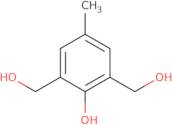
2,6-Bis(hydroxymethyl)-p-cresol
CAS: 91-04-3
Ref. 3D-FB34747
| 1kg | 806,00 € | ||
| 5kg | 2.208,00 € | ||
| 100g | 199,00 € | ||
| 250g | 369,00 € | ||
| 500g | 522,00 € |
Información del producto
- (2-Hydroxy-5-methyl-1,3-phenylene)dimethanol
- 1,3-Benzenedimethanol, 2-hydroxy-5-methyl-
- 2,3-Bis(Hydroxymethyl)-4-Methylphenol
- 2,6-Bis(Hydroxymethyl)-4-Methylphenol
- 2,6-Di(Hydroxymethyl)-4-Methylphenol
- 2,6-Di(hydroxymethyl)-p-cresol
- 2,6-Dimethylol-4-methylphenol
- 2,6-Dimethylol-p-cresol
- 26Dmpc
- 4-Methyl-2,6-bis(hydroxymethyl)phenol
- Ver más sinónimos
- AV Lite 26DMPC
- Dml-Pc
- NSC 15838
- α<sup>1</sup>,α<sup>3</sup>,2-Trihydroxymesitylene
- α<sup>1</sup>,α<sup>3</sup>-Mesitylenediol, 2-hydroxy-
- α1,α3-Mesitylenediol, 2-hydroxy-
- 2-Hydroxy-5-methyl-1,3-benzenedimethanol
2,6-Bis(hydroxymethyl)-p-cresol (BHMC) is a cross-linking agent that reacts with the hydroxyl groups of polymers to form covalent bonds. This reaction is irreversible and has been shown to be effective in thermal expansion applications. BHMC is insoluble in water and so can be used as a proton donor for the synthesis of polymer hydrogels. BHMC has also been used as a molecular modeling probe for studying protein structure and function. This compound reacts with nucleophiles by nucleophilic attack on the carbonyl carbon atom, producing an intermediate that tautomerizes to the corresponding enone. The reaction mechanism involves formation of a tetranuclear transition state followed by acid catalysis. Functional groups such as -OH, -NH2, or -COOH are required for this reaction to occur. NMR spectra have shown that there are three different chemical structures
Propiedades químicas
Consulta técnica sobre: 3D-FB34747 2,6-Bis(hydroxymethyl)-p-cresol
Si desea solicitar un presupuesto o realizar un pedido, por favor añada los productos deseados a su carrito y solicite un presupuesto o pedido desde el carrito. Es más rápido, más barato, y podrá beneficiarse de los descuentos y las ventajas disponibles.





